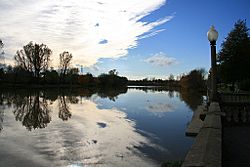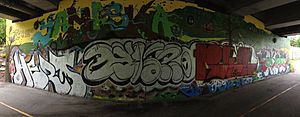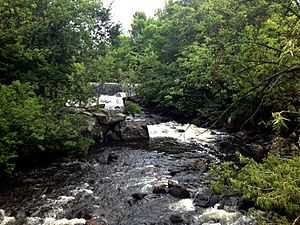Yamaska River facts for kids
Quick facts for kids Yamaska River |
|
|---|---|

The Yamaska River near Saint-Hyacinthe
|
|
 |
|
| Native name | Rivière Yamaska |
| Country | Canada |
| Province | Quebec |
| Region | Montérégie, Centre-du-Québec |
| City | Saint-Hyacinthe |
| Physical characteristics | |
| Main source | Brome Lake Brome Lake, Montérégie, Quebec, Canada 194 m (636 ft) 45°15′N 72°31′W / 45.250°N 72.517°W |
| River mouth | Lac Saint-Pierre (Saint Lawrence River) Saint-François-du-Lac, Centre-du-Québec, Quebec, Canada 46°06′50″N 72°56′13″W / 46.11389°N 72.93694°W |
| Length | 160 km (99 mi) |
| Basin features | |
| Basin size | 4,784 km2 (1,847 sq mi) |
The Yamaska River is a river in southern Quebec, Canada. It starts in the Eastern Townships and flows into Lake Saint Pierre, which is part of the Saint Lawrence River. The Yamaska River is about 177 kilometers (110 miles) long.
This river flows through almost twenty towns. It is a very important source of fresh water for these communities. Over time, people have changed the river and its banks a lot. This started when the first European settlers arrived and continues today.
In the past, the river was full of life. However, pollution from cities, factories, and farms has made it one of the most polluted rivers in Quebec. Farm waste and pesticides are big problems. Even so, many towns still use the Yamaska as their source for drinking water.
Even with pollution, some plants and animals still live along the Yamaska. People in different towns are working to reduce human impact on the river. The Yamaska is used for fun activities like fishing and boating. However, it is not safe for swimming.
For many years, people have been worried about the river's pollution. In places like Granby, citizens, experts, and groups are working together. They study the river, keep track of its health, and share ways to help it. These efforts have led to community art and events. These events help speak up for the animals and plants that cannot speak for themselves.
Contents
What's in a Name?
The name Yamaska first appeared in the 1600s. Before that, Samuel de Champlain called it "Rivière de Gennes" in 1609. Later, it was known as "rivière des Savanes."
The word "Yamaska" likely comes from the Abenaki language. It might mean "there are rushes off the coast" or "there is much hay." This name probably refers to Lavallière Bay at the river's mouth. This area has lots of plants growing in a marsh. Another idea is that the name comes from the Algonquian languages. It could mean "river of the savannas" or "river with muddy waters."
Because its origin is a bit unclear, the name has changed over time. Sometimes it was called "Maska" or "Masca." The people of Saint-Hyacinthe are even named after this shorter version. The river was officially named Rivière Yamaska on December 5, 1968.
River's Journey
How Water Flows
The Yamaska River's drainage basin covers 4,784 square kilometers (1,847 square miles). The average amount of water flowing out of it is 87 cubic meters (3,072 cubic feet) per second. This is quite slow compared to nearby rivers like the Richelieu River and Saint-François River.
The amount of water in the Yamaska changes with the seasons. It flows fastest in spring when snow melts and in fall due to rain. It flows slowest in winter and summer.
There are not many large natural lakes in the Yamaska's basin. Only three are bigger than one square kilometer: Brome Lake, Roxton Lake, and Waterloo Lake.
Where the River Goes
The Yamaska River starts at 193 meters (633 feet) high, north of Brome Lake. It flows west until it reaches Farnham. In this part, it is at the foot of the Appalachian Mountains. Two smaller rivers join it here: the North Yamaska River (which flows through Granby) and the Yamaska South East River.
After Farnham, the river turns north. It then enters the lowlands of the Saint Lawrence River. Its main branch, the Rivière Noire (Black River), joins it at Saint-Damase. The Yamaska then flows through its biggest town, Saint-Hyacinthe. Finally, it reaches its mouth at Lake Saint Pierre, west of Saint François Bay.
Smaller Rivers Joining the Yamaska
Some of the main rivers that flow into the Yamaska are the Noire, South-East Yamaska, and North Yamaska rivers.
- Rivers joining from the West (Left Shore):
* Rivière Pot au Beurre (Yamaska River tributary) * Le Petit Chenail (Yamaska River tributary) * Saint-Louis River * Salvail River * South-West Yamaska River * Yamaska South East River
- Rivers joining from the East (Right Shore):
* North Yamaska River * Rivière à la-Barbe * Noire River * Rivière le Renne * Jaune River * Rouge River * Chibouet River * David River
Towns Along the Yamaska
The Yamaska River flows through many towns and areas. These include:
- In Brome-Missisquoi Regional County Municipality: Lac-Brome, Bromont, Brigham, Farnham
- In La Haute-Yamaska Regional County Municipality: Saint-Alphonse-de-Granby, Granby
- In Rouville Regional County Municipality: Ange-Gardien, Saint-Césaire
- In Les Maskoutains Regional County Municipality: Saint-Damase, Saint-Hyacinthe, Saint-Barnabé-Sud, Saint-Simon, Saint-Hugues, Saint-Louis, Saint-Marcel-de-Richelieu
- In Pierre-De Saurel Regional County Municipality: Saint-Aimé, Massueville, Saint-David, Yamaska
- In Nicolet-Yamaska Regional County Municipality: Saint-François-du-Lac
Animals and Plants of the Yamaska
The Yamaska River is home to many different fauna (animals) and flora (plants). These include birds, fish, amphibians, reptiles, mammals, crustaceans, insects, fungi, lichen, and algae. They live in the water, on the banks, and in the nearby marshes.
Pollution has greatly harmed the nature around the river. For example, the number of fish species dropped from 70 to 33 between 1963 and 2003. To help, the Quebec government adds fish to the river to support sport fishing.
Fish in the River
The main fish found in the Yamaska are white sucker and Cyprinidae (a family of fish). In more polluted areas, you might find brown bullhead. Fish that people like to catch include muskellunge, Esox, black bass, Sander, yellow perch, pumpkinseed, and mud cat.
Over the years, the government has added fish for sport, such as brown trout, rainbow trout, muskellunge, Sander, yellow perch, brown bullhead, smallmouth bass, and brook trout.
Amphibians and Reptiles
Studies at Mont Yamaska have found over fifteen types of amphibians and even reptiles. These include the painted turtle and the Common garter snake. Common amphibians in the river are the dusky salamander, wood frog, and the green frog.
Lavallière Bay, near the river's mouth, is a very important home for amphibians. However, poaching (illegal hunting) of bullfrogs, northern leopard frogs, and green frogs limits their numbers.
Art for the River

On May 11, 2013, two community artworks were unveiled: "URGENCE YAMASKA" (Yamaska Emergency) and "LA YAMASKA, C'EST NOUS..." (The Yamaska, it is us...). This was part of the Art-Yamaska project. The art shows ideas about the river's health and shares clear environmental messages. The project aims to teach people about caring for the Yamaska.
Besides the art being shown at Granby's water pumping station, the project included poetry readings, a photo show, and workshops to create murals and mosaics. It all ended with a celebration day for the river in 2013. These murals are now very well-known because they are located near a popular cycling path.
In May 2015, a new art message was added to the Art-Yamaska project. It was called "Qu'es-tu devenu Yamaska?" (What have you become, Yamaska?). This mural is a few kilometers downstream on the same cycling path. The non-profit group Atelier 19 held workshops for youth. They created an environmental message to be placed under and on the sides of the Patrick-Hackett bridge. This bridge is known for its vandalism in the form of graffiti art. The new message was created with inspiration from that art style.



